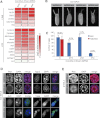shutdown is a component of the Drosophila piRNA biogenesis machinery
- PMID: 22753781
- PMCID: PMC3404366
- DOI: 10.1261/rna.034405.112
shutdown is a component of the Drosophila piRNA biogenesis machinery
Abstract
In animals, the piRNA pathway preserves the integrity of gametic genomes, guarding them against the activity of mobile genetic elements. This innate immune mechanism relies on distinct genomic loci, termed piRNA clusters, to provide a molecular definition of transposons, enabling their discrimination from genes. piRNA clusters give rise to long, single-stranded precursors, which are processed into primary piRNAs through an unknown mechanism. These can engage in an adaptive amplification loop, the ping-pong cycle, to optimize the content of small RNA populations via the generation of secondary piRNAs. Many proteins have been ascribed functions in either primary biogenesis or the ping-pong cycle, though for the most part the molecular functions of proteins implicated in these pathways remain obscure. Here, we link shutdown (shu), a gene previously shown to be required for fertility in Drosophila, to the piRNA pathway. Analysis of knockdown phenotypes in both the germline and somatic compartments of the ovary demonstrate important roles for shutdown in both primary biogenesis and the ping-pong cycle. shutdown is a member of the FKBP family of immunophilins. Shu contains domains implicated in peptidyl-prolyl cis-trans isomerase activity and in the binding of HSP90-family chaperones, though the relevance of these domains to piRNA biogenesis is unknown.
Figures




References
-
- Aravin AA, Naumova NM, Tulin AV, Vagin VV, Rozovsky YM, Gvozdev VA 2001. Double-stranded RNA-mediated silencing of genomic tandem repeats and transposable elements in the D. melanogaster germline. Curr Biol 11: 1017–1027 - PubMed
-
- Aravin A, Gaidatzis D, Pfeffer S, Lagos-Quintana M, Landgraf P, Iovino N, Morris P, Brownstein MJ, Kuramochi-Miyagawa S, Nakano T, et al. 2006. A novel class of small RNAs bind to MILI protein in mouse testes. Nature 442: 203–207 - PubMed
Publication types
MeSH terms
Substances
Grants and funding
LinkOut - more resources
Full Text Sources
Molecular Biology Databases
